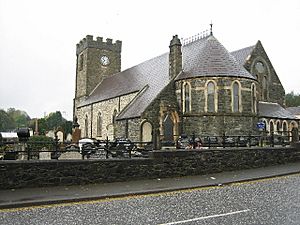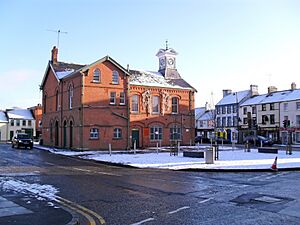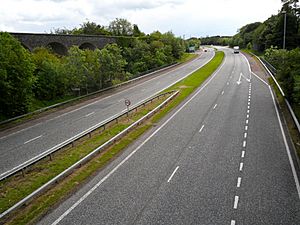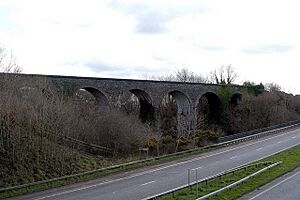Dromore, County Down facts for kids
Quick facts for kids Dromore
|
|
|---|---|
 Dromore Cathedral |
|
| Population | 6,395 (2021 census) |
| Irish grid reference | J201533 |
| • Belfast | 19 miles (31 km) |
| District |
|
| County | |
| Country | Northern Ireland |
| Sovereign state | United Kingdom |
| Post town | Dromore |
| Postcode district | BT25 |
| Dialling code | 028, +44 28 |
| Police | Northern Ireland |
| Fire | Northern Ireland |
| Ambulance | Northern Ireland |
| EU Parliament | Northern Ireland |
| UK Parliament |
|
Dromore is a small market town in County Down, Northern Ireland. Its name comes from the Irish words Droim Mór, which mean "large ridge". It is part of the Armagh City, Banbridge and Craigavon area.
Dromore is about 19 miles (30 km) southwest of Belfast. It sits on the main A1 road that connects Belfast to Dublin. In 2021, about 6,395 people lived there.
The heart of Dromore is Market Square. It has a very old set of stocks, which were used long ago to punish people. The town was once known for making linen. You can still see parts of an old castle and earthworks here. There is also a large mound, called "the Mound," which was once a fort.
Contents
History of Dromore
The name Dromore comes from the Irish Droim Mór, meaning "large ridge." Over time, it was also spelled Drumore or Drummore.
Early Forts and Battles
In the early 1200s, after the Norman invasion of Ireland, a Norman knight named John de Courcy built a fort here. This type of fort is called a motte and bailey. It's known locally as "the Mound." It sits on a hill and offers great views of the River Lagan valley.
The Normans controlled Dromore until 1315. That's when Edward Bruce captured and destroyed the fort during a war.
Dromore was also an important religious center. A church group called Canons Regular started an abbey here in the 500s. It was founded by Saint Colman.
Destruction and Rebuilding
In 1641, during a rebellion, the town and its main church were completely destroyed. The church you see today was built in 1661 by a bishop named Jeremy Taylor. He is buried there. Another famous bishop, Thomas Percy, is also buried in the church. He designed the beautiful grounds around the bishop's palace. There's a monument to Thomas Percy in the Town Park.
A battle took place near Dromore on March 14, 1689. It was part of a conflict between two groups, the Jacobites and the Williamites. The Jacobites won, and about 400 Williamite soldiers died. This battle, known as the Break of Dromore, allowed the Jacobites to move north and take over Belfast.
Railway Days
Dromore had its own train station from 1863 to 1956. The railway line connected Dromore to Lisburn and Belfast. In 1876, the railway became part of the Great Northern Railway. The train line through Dromore closed on April 29, 1956.
A Time of Change
In 1920, there were some difficult times in Dromore. People attacked homes and businesses. During these events, one person was killed by a police bullet.
Later, during a period of conflict in Northern Ireland, Dromore also experienced violence. In 1976, a family of three civilians died in a bomb attack on their shop. In 1988, a civilian was shot and killed while waiting for a ride to work. These events were part of a wider period of unrest that affected many communities.
Dromore Today
A plan for Dromore's town center was made in 2003. It showed that many shops were empty, even though more people were moving to the town. This is because Dromore is close to the A1 road, making it easy for people to travel to Belfast for work.
Many new houses have been built on the edges of town. This means these new areas are not well connected to the town center. People from Dromore often travel to nearby Banbridge or Sprucefield to shop. However, more local shops are opening, so fewer people need to travel far to buy things.
The plan also noted that the River Lagan and the public space around Dromore Town Hall could be used better. The Market Square is very old, but it has traffic problems. In 2008, some buildings in the square were removed to create more public space.
People in Dromore
Many interesting people have lived in Dromore:
- Sir Jeffrey Donaldson: A Northern Ireland politician and Member of Parliament.
- Harry Ferguson (1884–1960): An inventor who helped make the tractor useful.
- Melissa Hamilton: A talented ballet dancer.
- Tyrone Howe: An Irish rugby player.
- David Humphreys: Another Irish rugby player.
- Sam Ferris: An Olympic marathon runner.
Education
Dromore has several schools for young people:
- Primary Schools
- Dromore Central Primary School
- St. Colman's Primary School
- Secondary Schools
- Dromore High School
Sport
Even though Dromore is a small town, it has many sports teams and places to play. The most popular sports are football and rugby union. Cycling, hockey, lawn bowls, and athletics are also popular.
Cycling
Dromore has several cycling clubs, like Dromore Cycling Club. Many local cyclists have won national and international awards.
- Séamus Downey competed in the 1984 Summer Olympics.
- His son, Sean Downey, won a bronze medal at the 2010 Commonwealth Games.
- Another son, Mark Downey, has won gold and silver medals in World Cup cycling events.
Football
Dromore has an intermediate football team called Dromore Amateurs F.C.. They play their home games at Ferris Park. The town also has a youth football club, Dromore Amateurs Youth Football Club. It started in 2005 and now has over 200 kids aged 5 to 17. They have many teams playing in different leagues. Football is also a popular social sport in Dromore.
Rugby
Rugby union is played by Dromore Rugby Football Club. They have three rugby pitches and a clubhouse. Their main team plays in the Ulster Qualifying League.
Ladies' Hockey
Dromore Ladies Hockey Club represents the town in field hockey. Their top team plays in a senior league. The club has won "Club of the Year" and has six senior teams and many junior teams. They play and train at Ferris Park.
Sports Facilities
The main sports place in Dromore is Dromore Community Centre, also called Holm Park. It has two grass football pitches, two tennis courts, and a bowling green. Inside, there's a gym and a large hall. Another facility is Ferris Park, named after Olympian Sam Ferris. It has a floodlit hockey pitch, two floodlit tennis courts, and a grass football pitch. Both places are looked after by the local council.
Churches
Dromore has many different churches:
- St Colman's Catholic Church
- Banbridge Road Presbyterian Church
- Dromore Elim Pentecostal Church
- Dromore Reformed Presbyterian Church
- Dromore Methodist Church
- Dromore Free Presbyterian Church
- The Cathedral Church of Christ the Redeemer (Church of Ireland)
- Dromore Baptist Church
- Dromore Non-Subscribing Presbyterian Church
- First Dromore Presbyterian Church
Transport
Roads
Dromore has good bus services. The Translink Goldline Express bus service 238 runs between Belfast and Newry. The Ulsterbus service 38 connects the town to Belfast, Banbridge, and Lisburn.
It's a quick drive from Dromore to Belfast, Lisburn, and Banbridge because of the good A1 road and M1 motorway. Belfast International Airport is about 40 minutes away. Dublin Airport is about 70 to 80 minutes away. The town was on the main Belfast to Dublin route for hundreds of years, but a bypass road was built in 1972.
In 2009, new road junctions were built to make the A1 road safer. These included underpasses to help traffic flow better.
Railways
Dromore was once on the Banbridge, Lisburn and Belfast Junction Railway line. This line was part of the Great Northern Railway. Near the old Dromore Railway Station is the Dromore Viaduct. This impressive bridge, 74 feet (23 meters) tall with 7 arches, carried trains across the River Lagan. Dromore Station opened in 1863 but closed on April 30, 1956.
Communications
The phone code for Dromore, like the rest of Northern Ireland, is 028. Local landline numbers usually start with 028 9269.
Townlands
Dromore grew up in an area called a townland. Here are some townlands that are now part of Dromore, with what their names likely mean:
- Balleny: Means "O'Heaney's townland."
- Ballymacormick: Means "MacCormick's townland."
- Ballymaganlis: Means "MacAwley's townland."
- Ballyvicknacally: Means "townland of the hag's son."
- Drumbroneth: Means "Brónach's ridge."
- Lurganbane: Means "long white ridge."
See also
 In Spanish: Dromore para niños
In Spanish: Dromore para niños





